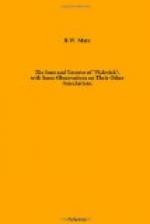The last tavern mentioned in The Pickwick Papers is the “excellent public-house near Shooter’s Hill, “to which Mr. Weller, senior, retired. Unfortunately it was never named, nor has it been identified. Continuing to drive a coach for twelve months after the Pickwick Club had ceased to exist, he became afflicted with gout and was compelled to give up his lifelong calling. The contents of his pocket-book had been so well invested by Mr. Pickwick, we are told, that he had a handsome independence for the purpose of his last days. At Shooter’s Hill he was quite reverenced as an oracle, boasting very much of his intimacy with Mr. Pickwick, and retaining a most unconquerable aversion to widows.
CHAPTER XVIII
PICKWICK AND THE “GEORGE” INN
Certain traditional legends naturally grow round our old London landmarks and, when once started, no matter how conjectural, they are hard to overtake or suppress.
The George Inn, Southwark, is an instance of this, and the legend that is prone to cling to it is that it was the original of the White Hart Inn of Pickwick fame; the contention being that Dickens, when writing so faithfully of the “White Hart” in Chapter X of The Pickwick Papers, where Sam Weller was first discovered, described the “George” and called it after its near neighbour, the “White Hart.” This contention, we submit, has no justification whatever. The only reason, therefore, for referring to it here, is with a view to dispelling the illusion.
It is surprising that so good a Dickensian as the late J. Ashby Sterry should have been one of those who favoured the idea. Whether he was the first to do so we are not aware. But in his very interesting and informative article entitled “Dickens in Southwark,” in The English Illustrated Magazine for November, 1888, he states it as his opinion that the “George” was the original of the “White Hart,” and reverted to the same idea in The Bystander (1901). The following extract from the former article contains the argument he used to substantiate his claim:
“Moreover it (the ‘George’) is especially notable as being the spot where Mr. Pickwick first encountered the immortal Sam Weller. The ‘White Hart’ is the name, I am aware, given in the book, but it is said that Dickens changed the sign in order that the place should not be too closely identified. This was by no means an unusual custom with the novelist. I think he did the same thing in Edwin Drood, where the ‘Bull’ at Rochester is described under the sign of the ‘Blue Boar.’ A similar change was made in Great Expectations, where the same inn is disguised in like fashion, in the account of the dinner given after Pip was bound apprentice to Joe Gargery. The ‘White Hart’ is close by, on the same side of the way, a little nearer London Bridge, but little, if anything, is remaining of the old inn, and the whole of the place and its surroundings have been modernised.




